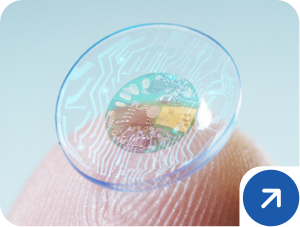If you use computers and other digital devices frequently, you’ve likely experienced headaches or migraines, sore neck, and dry eyes before. These symptoms are related to digital eye strain, an irritating condition.
Blue light glasses are a popular suggestion when someone experiences headaches and other symptoms related to digital eye strain, because they effectively filter out blue light. While they can help reduce symptoms of eye strain, there may be other reasons you’re experiencing headaches.
Visiting your eye doctor can help determine the underlying cause of your eye strain and headaches. Continue reading to learn more about digital eye strain, blue light glasses, and if they can relieve the headaches associated with this condition.
What is Blue Light?
You’re exposed to blue light every day through several sources, including the sun, phones, laptops, and televisions. It’s a short wavelength, high-energy light that combines with the other colours of the visible light spectrum to create the white light you see when the sun is shining.
Blue light can benefit you in several ways; it can help:
- Boost alertness
- Help memory
- Raise mood
- Improve attention span & reaction times
While blue light can have positive effects, too much exposure may impact your health.
How Can Blue Light Affect Your Health?
Like ultraviolet (UV) light, blue light can increase your risk of eye disease with increased exposure.
Blue light emits from digital screens, making screen time, especially at night, affect your sleep cycle. Exposure from artificial sources can interrupt your circadian rhythm, signalling your brain to wake up when it should be preparing to rest. Avoiding using or turning off your digital devices at least 3 hours before bed can help you sleep easier.
There are theories that blue light can cause digital eye strain, leading to irritated eyes, sore shoulders, and headaches.
What is Digital Eye Strain?
Digital eye strain is a condition causing your eyes to become irritated and uncomfortable after extended focus when using digital devices. In a world where people rely on computers more than ever, this condition can be prevalent. Experts believe that approximately 50% of computer users experience digital eye strain symptoms.
These symptoms can include:
- Sore, tired, or burning eyes
- Watery eyes
- Dry eyes
- Blurred or double vision
- Headache
- Sore neck, shoulders, or back
- Light sensitivity
If you’re experiencing any symptoms of digital eye strain, what causes this irritation?
What Causes Digital Eye Strain?
Many factors can influence digital eye strain, but this condition typically occurs when your eyes become tired from overuse, such as driving, reading, or using the computer.
Common causes of eye strain can include:
- Looking at digital screens
- Reading without taking breaks to rest your eyes
- Doing activities requiring extended focus
- Being exposed to bright light & glare
- Straining to see in dim light
- Being stressed or tired
Several causes of digital eye strain are related to computer use. You may blink up to 50% less when using the computer, making your eyes tired and dry.
It’s common for people to view their devices from poor distances and angles or use devices with reflection and glare. These factors can make your eyes work harder, straining them.
You may have heard of blue light glasses as a solution for headaches and other symptoms of digital eye strain, but how effective are these products?

Can Blue Light Glasses Help With Migraines & Headaches?
These specialized glasses effectively filter blue light, but there is no evidence blue light contributes to digital eye strain. Some experts don’t recommend blue light glasses for preventing the headaches and irritation associated with this condition.
While blue light exposure doesn’t cause digital eye strain symptoms, these glasses may help reduce general eye strain.
If you’re bothered by headaches when working on the computer, there are other ways you can address this issue besides blue light glasses. Treatment for digital eye strain typically focuses on prevention, and there are several changes you can make to prevent irritated and tired eyes.
Preventing Digital Eye Strain
If you’re experiencing symptoms of digital eye strain, such as headaches, the best thing you can do is rest your eyes. In the future, you can make several changes to your habits and environment to prevent these symptoms.
For your environment, you can reduce the chance of digital eye strain symptoms by:
- Raising the contrast on your screen
- Making text larger
- Changing the brightness of your screen to match your surroundings
- Raising your device’s refresh rate to prevent screen flickering
- Setting up your workstation away from incoming sunlight to prevent glare & brightness
- Sitting at least an arm’s length away from your computer screen
Besides these changes, you can establish a habit that can help you use digital devices without straining your eyes, called the 20/20/20 rule.
The 20/20/20 Rule
The 20/20/20 rule gives your eyes a break when working on the computer, helping you avoid irritating headaches. The rule is simple: take a 20-second break every 20 minutes to look at something at least 20 feet away.
If your headaches continue despite making these changes, speak with your optometrist. Your symptoms may be a sign of an underlying issue.
Don’t Let Headaches Rule Your Life
While headaches can happen, you shouldn’t experience them whenever you use digital devices. Blue light glasses may not be effective, but there are several changes you can make to your computer habits to prevent digital eye strain. If you’re experiencing symptoms of digital eye strain, book an appointment with your optometrist.















